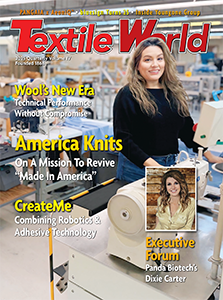 By Jim Borneman, Editor In Chief
By Jim Borneman, Editor In Chief
Turbulent times call for increased communication and open dialogue among colleagues and competitors and, luckily enough, Techtextil North America (TTNA) 2025 in Atlanta offered just that.
Sharing the show floor with exhibitors and visitors from a broad array of industry sectors, from various parts of the country — and world— presented a chance to get up-close with the industry and hear what was affecting them, their businesses and their view of the future.
By and large, taking place during sweeping changes in U.S. tariffs, a ferociously fast news cycle, and economic implications that welcomed broad speculation, TTNA was perfectly timed.
Two themes seemed to emerge — one for machinery and technology companies, and one for textile manufacturers.
Nothing was concrete, but machinery companies seemed frustrated that the current business climate had stalled capital equipment investments. Not all, but many had projects technically approved and ready to go, but manufacturers have been hesitant to pull the trigger. Some suppliers said they had been sidelined for more than a year awaiting the final go ahead.
Even so, there was an optimism regarding interest in new technology and upgrading, with some companies quietly sharing good news.
Many of the manufacturers commented that business was very strong. One even said that a lack of packing materials prevented a shipment of goods the company had rushed to produce.
But even with that good news, there was serious confusion about what the future holds. Was this just a front-end loading of orders to get ahead of the chaos that may ensue? Was this the proverbial devil-you-know reaction to locking in orders and inventory to smooth out future supply chain bumps?
This was simply not a typical show, or the typical TTNA atmosphere. It was interesting to see the way international trade questions were affecting people differently. The USMCA-focused supply chain participants were uneasy, but optimistic that business would continue as trade issues settle down. Many of the European machinery producers were really scratching their heads — wondering about serious cost increases to supply U.S. manufacturers if tariffs take hold and are here to stay.
For an industry full of participants who usually — rightly or wrongly — have a strong awareness of how their businesses are performing and a confident view of their the future — all bets were off.
Beyond tariffs, the possibility of a tax bill that would allow for immediate expensing of research and development, full depreciation of capital equipment expenses, and other business friendly components was a positive, but lingering consideration in the mix.
Beyond that, there were exhibitors who were in gear, moving forward, with seemingly no time to be sidetracked by navel gazing.
It was kind of refreshing, but there were people at the show who really felt like this was just another chapter. They have been kicked around, hung out to dry, and counted among the dead before and it really didn’t matter — they are survivors. But trying to figure out the issues while they are in motion is like trying to putt a golf ball in a tornado. “Just tell me the rules when you figure them out, and I’ll chart a course to navigate those waters,” someone said.
So, without any half-baked predictions or tired if-then scenarios, the survivors have a point. Set the rules, and U.S. Textiles will chart a course — but there’s still not much time for putting.
2025 Quarterly Issue II




